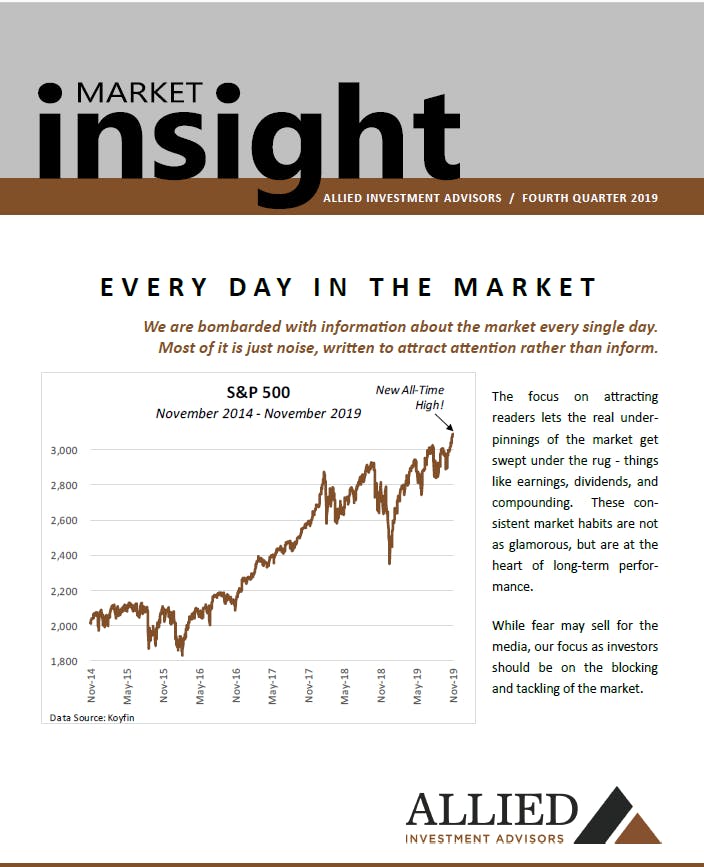Q4 2019: Every Day in the Market
November 14, 2019
We are bombarded with information about the market every single day. Most of it is just noise, written to attract attention rather than inform.
The focus on attracting readers lets the real underpinnings of the market get swept under the rug - things like earnings, dividends, and compounding. These consistent market habits are not as glamorous, but are at the heart of long-term performance.
While fear may sell for the media, our focus as investors should be on the blocking and tackling of the market.

The Market is Beautifully Boring
Day-to-day, the market can be incredibly volatile, so much so that it often shakes investors out. Since this market cycle began in October 2007, the wildest days have been up +11.6% (October 13, 2008) and down -9.0% just two days later on October 15th (October 2008 was at the depths of the Financial Crisis). This is real volatility, and if we don’t have our portfolios positioned correctly ahead of time, the psychology of watching 9% of your savings disappear in one trading session can be overwhelming.
If we focus just on those days, we only see the trees and miss the forest.
When we step back and look at the average day in the market, it begins to look beautifully boring. Over the past twelve years, the average daily gain in the market has been 0.03%. Nothing happens on the average day! Compounded over 3,000 trading days, however, and that 0.03% per day turns into a price gain (not including dividends, which we will get to next) of nearly 90% (5.4% per year).
While the worry of the day may cause short-term concern, investors who ignore the market’s volatility have historically been rewarded.

Dividends
It is rare that dividends make the headlines, unless some well-known company is forced in to a cut. You don’t get much attention by reporting that today, just like yesterday, the market paid us for owning it. Yet that is the consistent, boring habit of the market – made even better since the amount we are paid typically grows over time.
Since 1960, the per share dividend on the S&P 500 has grown at 5.9% per year - from $1.87 in 1960 to a current $56 per share. This works out to a 2.0% yield today, but if payouts keep growing at historical rates, in 10 years you will be earning a 3.6% yield on your cost basis, and in 20 years it will be a 6.3% yield. If your dividends grow even faster than the historic 5.9% rate (like some of the blue chips we currently own), the yield compounding only gets better.
Thanks to growth and reinvestment, studies have shown that dividends can account for up to 75% of the market’s return over long periods.
The humble dividend should not be ignored when it comes to investing.

Our Emotions Work Against Us
Behavioral Finance, a new area of focus in investing over the last two decades, is the study of psychology on financial decisions. At its base, Behavioral Finance has shown that investors are not always rational, they have limits to their self-control, and they are influenced by biases.
Some of the more interesting biases are:
- Loss Aversion: The pain of a loss is about twice as powerful as the joy of a gain. Investors are hesitant to lock in losses, so they often hold on to losing positions while selling their winners (they water their weeds and pull their flowers).
- The Narrative Fallacy: We love a good story, which the media exploits with their “worry-of-the-day” headlines. The story often displaces the underlying facts and data of the situation.
- Recency Bias: Investors believe what happened recently will continue to happen and this can cause investors to chase performance, piling into the hot performing asset class.
The best way to handle these and the many other investing biases:
- Be disciplined in your investing and finances (and find an advisor who does the same).
- Be objective, focusing on the data and not the narrative.
- Work with your advisor to put an investing plan in place.
- Find the right portfolio mix that fits you and your risk tolerance.
- Ignore the noise. While the daily headlines might appeal to your biases, stay focused on the real underpinnings of the market.
We would be happy to sit down with you and discuss ways to implement any of the above suggestions.
If you have any questions about your account(s), or if there has been a change in your financial situation or investment objectives, please feel free to contact our team to schedule a meeting.

